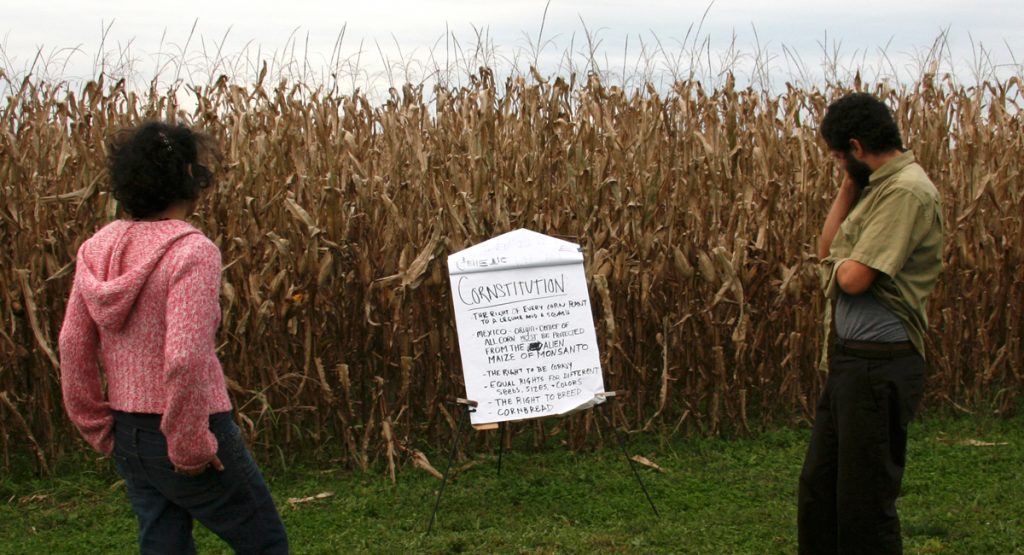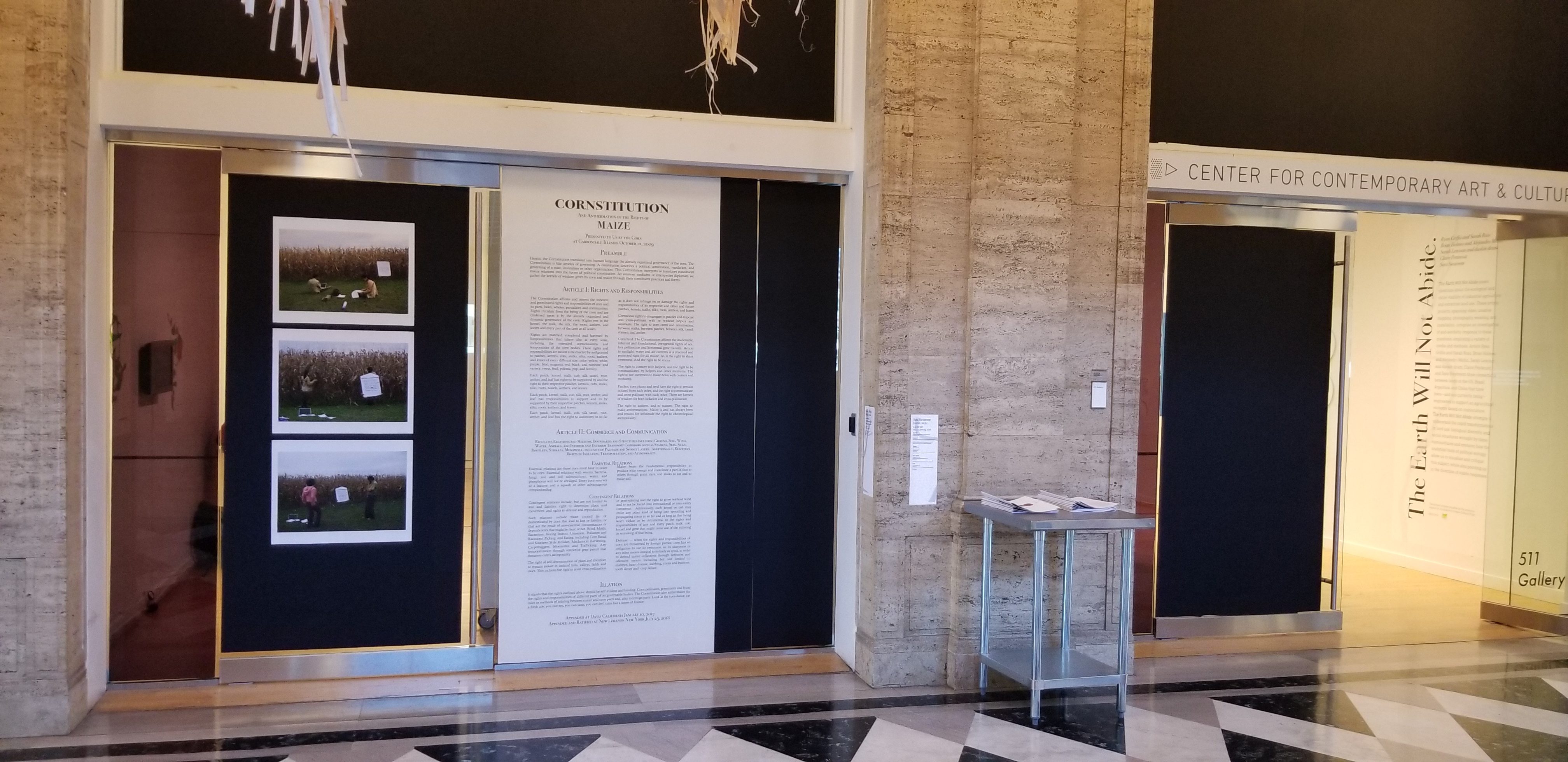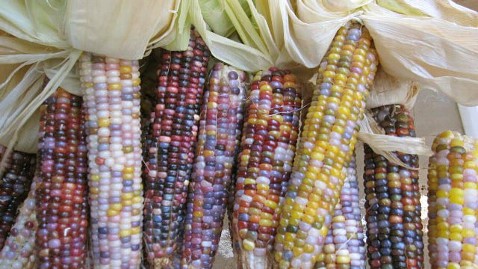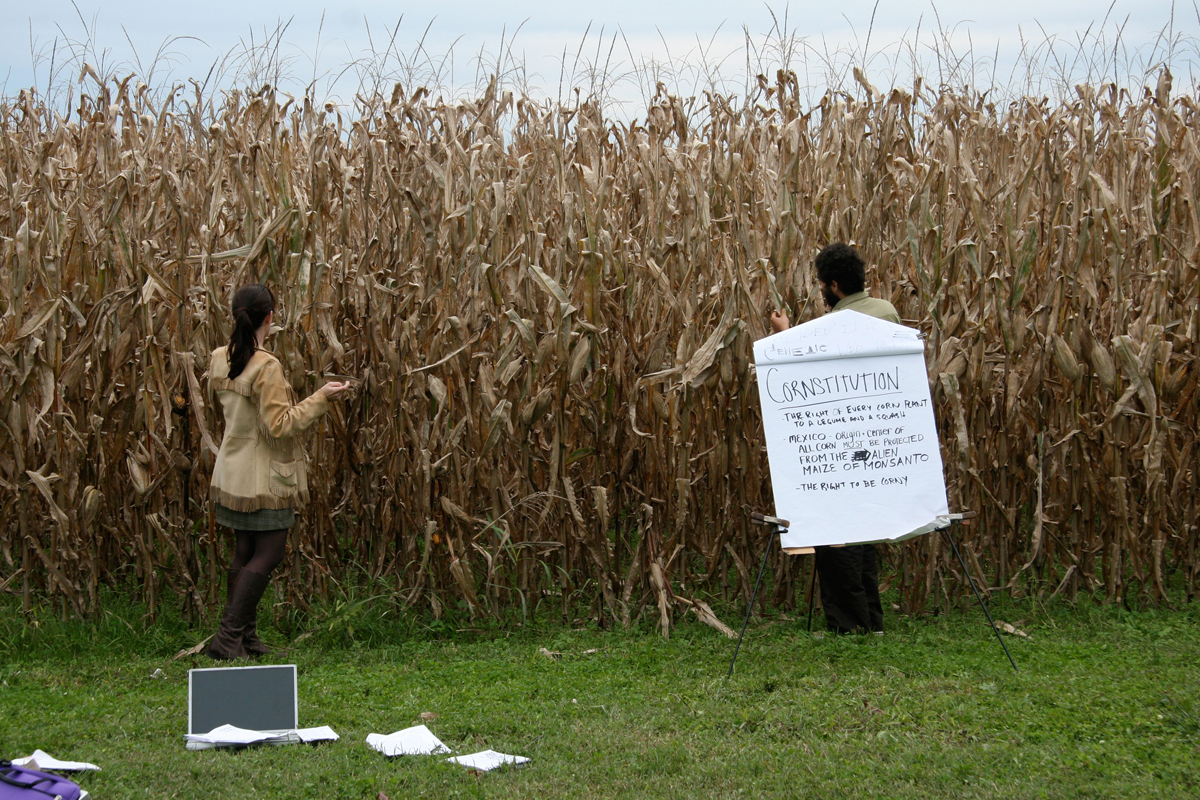Cornstitution; An Anthermation of the Rights of Maize
collaboration with Sarah Lewison
Performance 2014 ~ a cornfield in Little Egypt
Installation – Printed wall text (vinyl or installed large-format print) 2017-2019
~ The Earth Will Not Abide ~ Group exhibition: Chicago, Carbondale, Portland, Argentina.
Review in Art in America
CORNSTITUTION
AND ANTHERMATION OF THE RIGHTS OF
MAIZE
PRESENTED TO US BY THE CORN
AT CARBONDALE ILLINOIS OCTOBER 8, 2014
APPENDED AT DAVIS CALIFORNIA JANUARY 10, 2017
APPENDED AND RATIFIED NEW LEBANON NEW YORK JULY 23, 2018
Preamble
Herein, the Cornstitution translated into human language the already organized governance of the corn. The Cornstitution is like articles of governing. A constitution describes a political constitution, regulation, and governing of a state, institution or other organization. This Cornstitution interprets or translates constituent maize relations into the terms of political constitution. As amateur mediums or interspecies diplomats we gather the kernels of wisdom given by corn and maize through their constituent practices and forms.
Article I: Rights and Responsibilities
The Cornstitution affirms and asserts the inherent and germinated rights and responsibilities of corn and its parts, holes, wholes, partialities and communities. Rights circulate from the being of the corn and are conferred upon it by the already organized and dynamic governance of the corn. Rights rest in the kernel, the stalk, the silk, the roots, anthers, and leaves and every part of the corn at all scales.
Rights are matched, completed and leavened by Responsibilities that inhere also at every scale, including the extended cornsciousness and temporalities of the corn bodies. These rights and responsibilities are meant to be enacted by and granted to patches, kernels, cobs, stalks, silks, roots, anthers, and leaves of every different size, color; yellow, white, purple, blue, magenta, red, black, and rainbow; and variety; sweet, feed, polenta, pop, and hominy.
Each patch, kernel, stalk, cob, silk tassel, root, anther, and leaf has rights to be supported by and the right to their respective patches, kernels, cobs, stalks, silks, roots, anthers, and leaves.
Each patch, kernel, stalk, cob, silk, root, anther, and leaf has responsibilities to support and to be supported by their respective patches, kernels, stalks, silks, roots, anthers, and leaves.
Each patch, kernel, stalk, cob, silk tassel, root, anther, and leaf has the right to autonomy in so far as it does not infringe on or damage the rights and responsibilities of its respective and other and future patches, kernels, stalks, silks, roots, anthers, and leaves.
Cornscious rights to congregate in patches and disperse and cross-pollinate with or without helpers and assistants. The right to corn coms and cornimation, between stalks, between patches, between silk, tassel, stamen, and anther.
Corn bred: The Cornstitution affirms the inalienable, inherent and foundational, corngenital rights of sex, free pollination and horizontal gene transfer. Access to sunlight, water and air currents is a reserved and protected right for all maize. As is the right to share sweetness. And the right to be corny.
The right to consort with helpers, and the right to be communicated by helpers and other mediums. The right to use sweetness to make deals with carriers and mediums.
Patches, corn plants and seed have the right to remain isolated from each other, and the right to communicate and cross-pollinate with each other. There are kernels of wisdom for both isolation and cross-pollination.
The right to anthers, and to stamen. The right to make anthermations. Maize is and has always been and retains for infinitude the right to chronological atemporality.
Article II: Commerce and Communication
Regulates relations and mediums, boundaries and structures including Ground, Soil, Wind, Water, Animals, and interior and exterior transport corridors such as Stamens, Skin, silks, Rootlets, Stomata, Mesophyll, inclusive of palisade and spongy layers. Additionally, affirms rights to isolation, transportation,
and atemporality.
Essential Relations
Essential relations are those corn must have in order to be corn. Essential relations with worms, bacteria, fungi, soil and soil substructures, water, and phosphorus will not be abridged. Every corn reserves to a legume and a squash or other advantageous companionship.
Maize bears the fundamental responsibility to produce solar energy and contribute a part of that to others through grain, ears, and stalks to eat and make soil.
Contingent Relations
Contingent relations include, but are not limited too, loss and liability, right to determine place and movement, and rights to defense and reproduction.
Such relations include those created by or domesticated by corn that lead to loss or liability, or that are the result of non-essential circumstances or dependencies that might be there or not. Wind, Molds, Bacterium, Boring Insects, Urine, Pollution and Raccoons. Picking and eating, including Corn bread and southern style relishes. Carpetbaggers, monsantos and trafficking. Temporalization through restrictive gene patent that threatens corn’s atemporality,
The right to determine place and to remain isolate in isolated hills, valleys and dales. This includes the right to resist cross-pollination or gene-splicing and the right to grow without wind and to not be forced into international or inter-valley commerce. Additionally, each kernel or cob may enlist any other kind of being into spreading and propagating corns in so far and as long as that being won’t violate or be detrimental to the rights and responsibilities of any and every patch, stalk, cob, kernel and gene that might come out of the enlisting or recruiting of that being.
Defense — when the rights and responsibilities of corn are threatened by foreign parties, corn has an obligation to use its sweetness, or its sharpness or any other means integral to its body or spirit, in order to defend maize collectives through defensive and offensive means including but not limited to diabetes, heart disease, stabbing, corns and bunions, tooth decay and crop failure.
ILLATION
Corn pollinates, germinates and fruits the rights and responsibilities of different parts of its governable bodies. The Cornstitution also anthermates the rules or methods of relating between maize and corn parts and, also to foreign parts. Look at the corn dance, eat a fresh cob, you can see, you can taste, you can feel, corn has a sense of humor.





